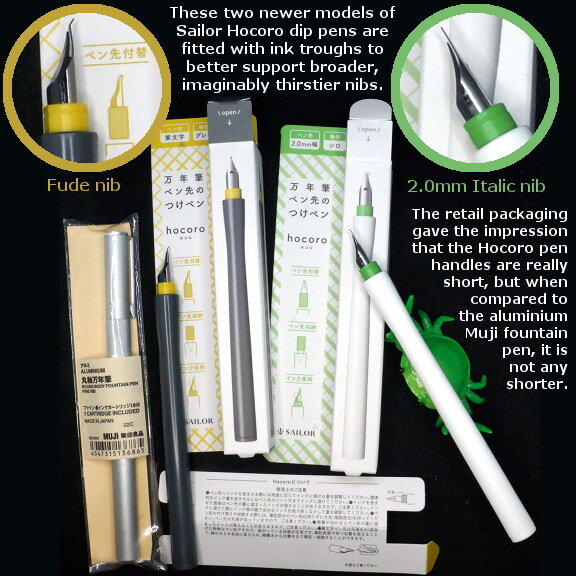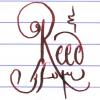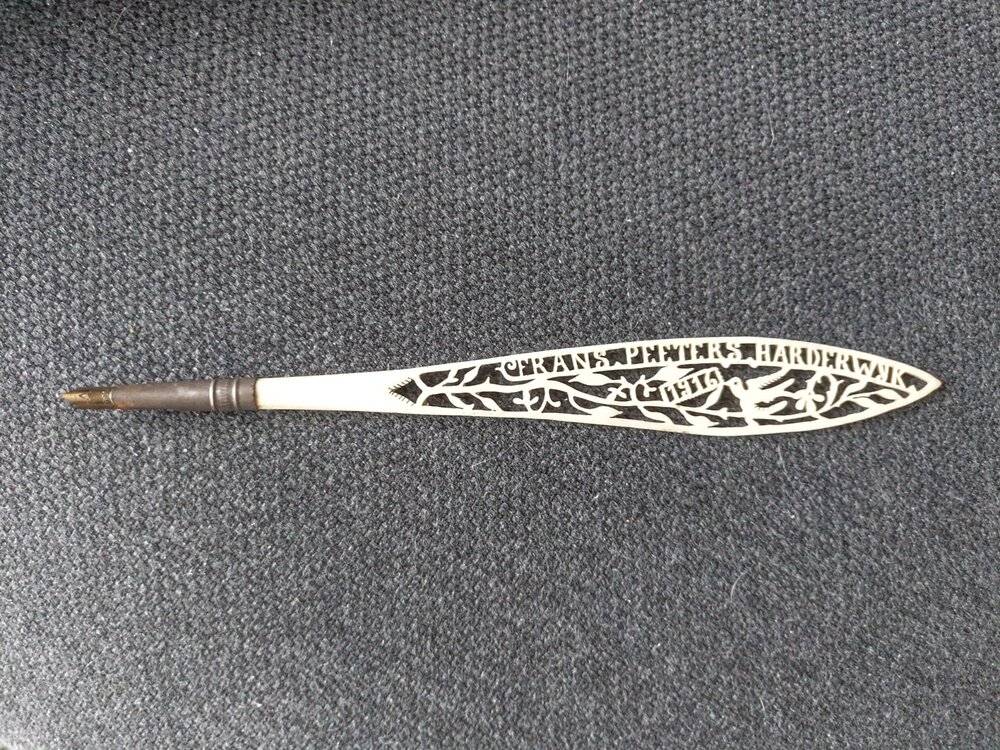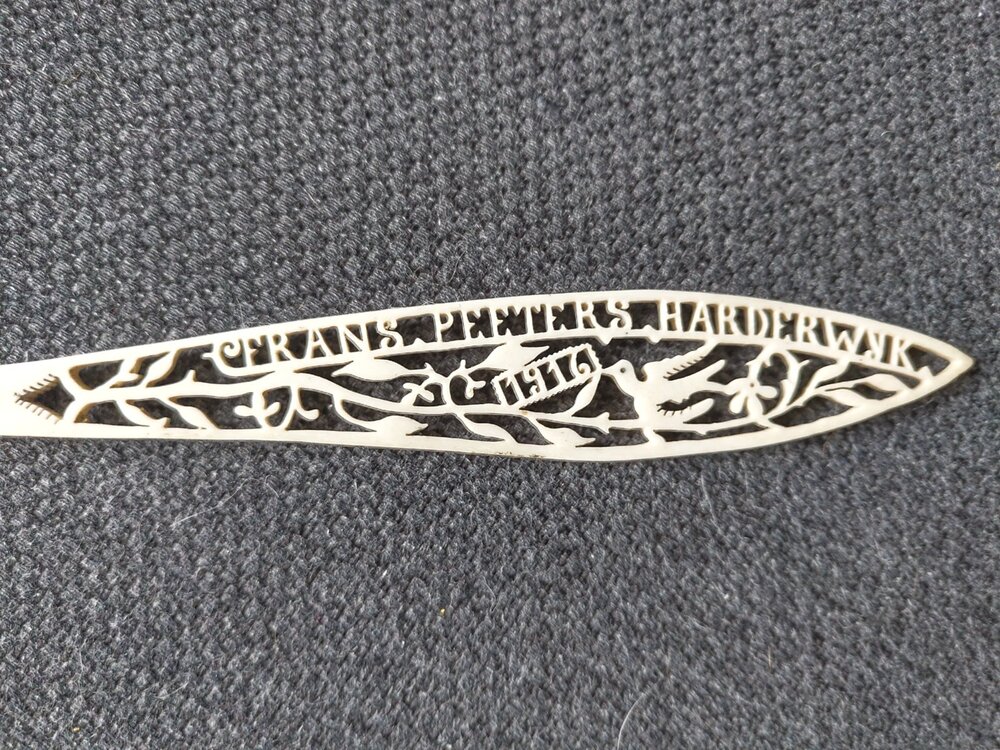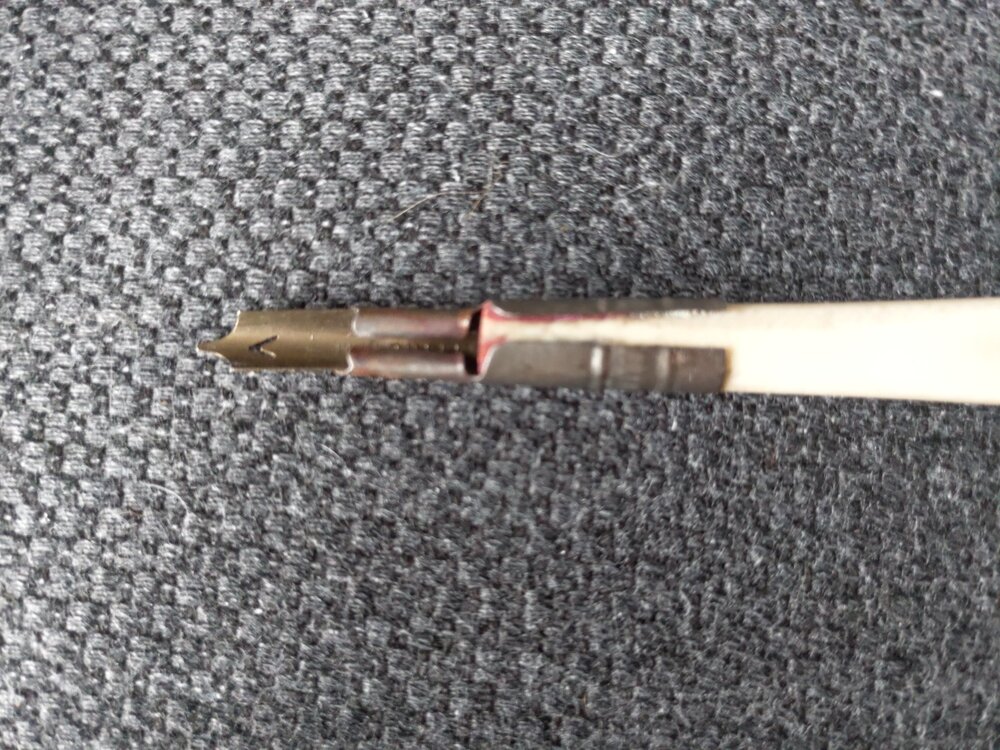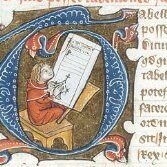Search the Community
Showing results for tags 'dip pen'.
-

Can one smooth the tip of a dip pen nib that is very scratchy?
The Scribe posted a topic in Of Nibs & Tines
I recently purchased a selection of dip pen nibs for Copperplate and Engrosser's Script. Some nibs perform beautifully smoothly on the upstroke like the Zebra G and the Brause EF66. However then there are the Hunt nibs I purchased like the Hunt 101 and 22B which are very scratchy! The Gillot 303 and 404 suffer the same fate. While I can ameliorate the scratchiness by using really smooth paper like Rhodia as well as using a very light touch I am wondering if I can use the same techniques and materials (e.g. 3M micromesh) to lightly round and polish the tine tips of these nibs as I have successfully used on my fountain pens? Anyone had experience doing this?- 6 replies
-
- nibs
- copperplate
-
(and 2 more)
Tagged with:
-
i am a traditional jewish kosher torah scribe, and this requires the use of IG inks on parchment, the IG is usually very thick and many scribes use dip pens for this reason. the ink (https://merkazhasofrim.com/sofrus/inks/hadar-ink.html) lays on top of the parchment and stays as a shiny layer. i myself use a architect nib on a twsby vac700r but i am thinking of getting an oblique and holding the flat part of the nib perpendicular to the top pf the paper to acheive this same angle and variation. the issue is that it will in all likelyhood dry on my pen and become unusable. does anyone know how the IG/thick dip inks write with the indigraph or have reccommendation for a pen for thick ink?
-
Found some nibs while hanging out before work earlier this week but the only holder I could find was way to narrow for my fat fingers, so a trip to the hardware store and a little elbow grease later and I have a holder tuned for each style of nib I know they are a little crude but they work :3
-
I once read a similar post about fountain pens on FPN. Since there are many dip pen users and collectors in FPN, I thought it would be interesting to know what is the oldest one in their possession. My humble collection consists of just three dip pen holders. One is a modern wooden straight holder and the other two are the oldest ones. I know this one is old but I couldn't figure out the exact time period. It's not very clear, but upon close inspection one can see "Calcutta" (old name of Kolkata, capital city of West Bengal state in India) imprinted on it. The second dip pen is much more dipped into history. It was gifted to me by one of my father's friend (in fact, the first one is also his gift). It belonged to his grandfather, Manoranjan Sengupta, who happened to be an Indian freedom fighter and a companion of the famous Indian revolutionary "Bagha" Jatin. (Here is the link of the Wikipedia page on Bagha Jatin. You will also find the name of Manoranjan Sengupta mentioned in the 'Death' section. https://en.m.wikipedia.org/wiki/Bagha_Jatin ) If Manoranjan Sengupta himself didn't inherit the holder from one of his predecessors then I think it might be from the early decades of 1900. I am not sure about the material of this pen. It feels somewhat like buffalo horn. Another possibility is laquer (must be hundreds of layers if it is really so) on wood. I am pretty proud of this holder. It thrills me when I hold it in my hand knowing that it was once used by a great man who sacrificed his life for the freedom of my nation. Now it's your to turn to tell me about the oldest dip pen in your collection.
-
Generally, I am not a fan of dip pens. Although most of my serious calligraphy friends, especially the professionals, use them by preference. Dip pens and I have never gotten along very well. The only type I have used in recent years is glass dip pens for ink testing. When I came across the Sailor hocoro pens by chance browsing an Italian pen shop's web site, I was sufficiently intrigued by several of its features to order one to try out. I ordered one with a 2.0mm italic nib and liked it enough to then order one with a 1.0mm italic nib. The things I like about the design include: 1) The relatively small size, making it very portable (unlike the usual dip pen). 2) The nib hides in the handle when not in use and is protected from damage. 3) The 2.0mm nib comes with a feed and a separate feed can be ordered for the 1.0mm nib. With the feed, the nib holds enough ink for quite a lot of writing, and flow is very good. 4) The pen handle is comfortable to hold, and it has one flat side which keeps it from rolling away. 5) A quick wash with water cleans the nib. The text produced is quite acceptable. Even the 1.0mm italic nib produces good thick/thin line differentiation. Here are some photos: I expect this to become my first line ink testing pen. We'll see how I feel about it after more experience. David
-
- sailor hocoro
- dip pen
-
(and 1 more)
Tagged with:
-
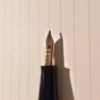
Making Gold Flex Nibs; From A Victorian Pen Catalogue
Lunoxmos posted a topic in Fountain & Dip Pens - First Stop
Credit given to David Armstrong from The Restorers Art Original article found here Copy of the catalogue found here Recently I came across a Victorian Era pen catalogue called the: "History of the invention and illustrated process of making Foley's diamond pointed gold pens" It starts off with a catalogue of the various products that the company offered, such as gold dip pens, and mechanical pencils, along with other bizarre combinations such as an instrument with a toothpick on one end and an ear spoon on the other. The main interest of the document, however, is that in the second half it details the history of the development of the Gold pen (or nib, as we would say these days), as well as the process in how these pens were made. After reading the catalogue myself, I along with David Armstrong and probably many other people as well, have concluded that the level of modern nib manufacturing is, though in my opinion, not exactly plagued by poor workmanship (a good nail nib is still a good nail nib), but has instead become complacent, perhaps unaware of the potential profits which could be obtained from the enthusiastic, albeit rather niche consumer group. (have a look at some of the prices that vintage flex fetches on eBay!) We have not really lost the technology or the method of producing flexible gold nibs. If you read the below copy-and-paste of the text, you can see that the only thing that was required to make the gold "flexible" was to hammer it; something that I believe with a little bit of will and determination we can replicate in a mechanical form, using machinery instead of a blacksmith, to make each one as precisely and accurately manufactured as the one before. "The nib of each Pen, as shown above, is hammered on a small anvil or stake, of curved surface, until the required spring or elasticity is secured, so that the nib of the Pen will bend almost double and again return to its proper position." Of course there are many things in the detailed process which can be automated due to our large advances in technology. For example, I believe that we have improved our tipping process, compared to when the Victorians were still figuring it out. Much of the tipping of the period was liable to falling out. In addition, we have automated much of the process of making nibs, the only part requiring human expertise being possibly the grinding, smoothing and inspecting, making the process faster and more consistent. I believe that if those high end companies, which probably have the money to invest in these sorts of things, decide to produce machinery which can hammer the nibs (tines), and strike upon the certain points with an exact pressure to produce the flexibility, then it is very possible that we will be able to produce modern flex nibs which will rival, or even better the flex nibs of the past. Here is a copy of the text which you may read at your own leisure. I have linked to the catalogue at the top of the post ( it's a big file so I recommend you look at it on a reasonably powerful device). (note that the use of the word "pens" is the Victorian equivalent of our "nibs", and the word "nibs" is the Victorian equivalent of our "tines") FORGE FOR MELTING THE GOLD. In this the Alloyed Gold is melted. It is fine Bar Gold (see page 43), and the quantity of alloy added is prepared with much care, and consists of pure Copper and Silver. A small quantity of each is added to the fine bar of gold. Pure Gold being too soft, the alloy is added to make it hard and durable and of a uniform elasticity. The alloyed gold is put into a sand crucible and placed in a charcoal fire, melted to a liquid and then poured into an iron ingot which produces a bar of the required width and thickness according to the size of Pen it is intended for, generally about half inch thick, 20 inches long, 1&1/2 inches in width (see E). After the bar is cooled it is removed from the ingot, the rough edge is filed smooth and hammered, and it is then ready for the ROLLING MILL, OR STOCK ROLLS. This machine rolls or stretches the bar of gold to perhaps ten times its original length, reducing it to a ribbon about 1/32 of an inch thick. Its width ought to be just enough to cut out two blank Pens. The machine is propelled by steam or hand power. It is complicated, very heavy, made and finished in the finest and most expensive manner, and regulated by two screws on each end. Each time the bar passes through the screws are turned down, until the required thickness is attained, and it is then ready for the BLANK PRESS AND DIE. After the bar of gold is rolled into a long thin ribbon, the blank Pen " C " is cut from it in two rows. One long strip or ribbon will cut from five hundred to a thousand blanks. The cutter is a lever press — with die set. The blank as it is cut drops through into a drawer underneath. This blank Pen is now ready for the BURRING MACHINE. This is used to mill out a recess across the point end of the blank "D" to receive the " Iridium " which is the celebrated Diamond Point of the Gold Pen. This done, the blank is now ready to have the Iridium set in, as is shown in the next Engraving. SELECTING AND PUTTING ON THE DIAMOND POINTS. This is done by placing a number of blanks in a row on a strip of wood made for that purpose. The diamond points being carefully selected, a small pencil brush is dipped into liquid borax and with it the points are picked up and set into the recess. The workman uses a microscope to enable him to place the points properly. When this is done, the " blank " is sent to the next man, who fixes the points permanently : SWEATING ON THE DIAMOND POINTS. A lot of blank Pens are placed in rows as above, on a flat piece of charcoal ; the blow pipe is then applied to the gas burner and a flame is directed steadily upon the point of the blank until the gold is thoroughly melted around the diamond or Iridium point. This is the " sweating" process (no solder being used) in making Foley's Pens. Hence it is that the points never come off. It requires much care and experience, for if the heat is applied a moment too long the whole Pen is melted and made useless. The point is now applied to the copper lathe (see 73) and brought to a square even face upon both sides and end. It is then ready for the blank rolls. The fine quality of Gold, over 16-karat fine, used in the manufacture of FOLEY'S Solid Gold Pens cannot be affected in the slightest degree by the strong acid with which most of the good inks are now made. Many of the Pens in the market at the present time are made of 10, 12 and 14-karat Gold and the points are put on with solder. The acid of the ink will turn the cheap Pens black and separate the points, which will soon fall off, and make the Pen worthless. Again, many Pens are made so light, being almost as thin as paper, that they soon wear out. A poorly made Gold Pen, no matter how cheap, is the most expensive in the end. THE BLANK ROLLS. With this machine the blank Pen is rolled down or stretched to the length shown above. This is done by placing the blank between the two rolls. The under roll has a recess in which the point is protected, and the pen is passed through the rolls several times until the required length is attained. The blank as shown above is now ready to have the Springiness or Elasticity hammered into it. HAMMERING TO PRODUCE THE SPRING OR ELASTICITY. The nib of each Pen, as shown above, is hammered on a small anvil or stake, of curved surface, until the required spring or elasticity is secured, so that the nib of the Pen will bend almost double and again return to its proper position. It is now in a rough and uneven shape and prepared for the second cut to give the Pen its proper form; by the SECOND CUTTING DIE AND PRESS. This operation takes off a narrow strip all around except at the point, and gives the Pen its proper even form in the flat state as above shown and it is then ready for the STAMPING PRESS. This is a screw press. The name stamp is set, and the pen, still flat, is placed on a hard steel plate with a guide to slide the pen into, so that every Pen is lettered uniformly and in exact position. Nearly one thousand Pens can be stamped in an hour. The Pen as above shown is now ready to have the sides raised up into shape, which is done in the RAISING UP MACHINE. This is a screw press of great power. With this, the Pen from its flat shape is bent into the round or partially cylindrical form. To insure perfect shape and per- manent set to the new curve, only a press of great power and dies of extreme exactness can be used successfully. This press is very heavy and complicated with many parts and very expensive fittings. The principal parts are the half round bed on which the flat Pen rests ; and the plunger, half round also, to fit exactly, which is struck down with great force by the action of the screw. This blow rounds the back and sides of the Pen. The plunger is brought up by an excentric and lever acting on two jaws, one on each side of the machine. This completes the perfect shape of the Pen as above shown in its well known form. This machine was invented by an ingenious Frenchman, John Countis, a machinist, while employed in Mr. Foley's factory. It is the most perfect and successful Raising Machine ever devised for Gold Pen making, and is capable of raising and shaping fifty Pens an hour. The next operation is to cut or divide the point in the Point, Cutting Lathe. CUTTING THE DIAMOND POINT. With this Point Cutting Lathe, after the Pen is carefully adjusted in a swing frame, the diamond or Iridium point is brought centrally upon the edge of a thin copper disk, about three inches in diameter, kept in rapid motion. The edge of the disk is charged with fine emeiy and oil. The Iridium is soon slit into two points, and thus is laid the foundation for the slit of the Pen. The Pen is next placed in a pen holder and passed over to the SLITTING LATHE. With this the slit is extended from the points to the full length of the nib. A very fine circular steel saw is used, and the skillful workman uses no guide. He simply places the Pen in a holder and with both hands and an experienced eye will slit, perfect and straight, one hundred Pens an hour. A fine hand-saw is used to perfect the end of the slit, which must end exactly perpendicular to both sides. This prevents the slit or Pen from cracking further up, and destroying the Pen. After slitting as above, the Pen is ready for BURNISHING THE NIBS. This is done with a hammer, burnisher and stake. Slitting the Pen removes more or less of the gold. The two edges must now be brought together again by hammering the outer edges of the nibs on the stake. The Pen is burnished on both sides to remove all unevenness ; and the nibs are set even by the fingers. After leaving the burnisher the Pen is ready to receive the most important part of its construction — from the GRINDING LATHE. This consists of one large and two or three smaller copper wheels and one tin slitter fitted on a steel spindle, running on true centers and finely finished. The tin slitter is charged with fine emery and oil. Now begins the most important work. After the Pen leaves the hand of the burnisher it goes at once into the hands of the GRINDER who should be not only an experienced workman and a good mechanic, but a man of intelligence, for he must understand thoroughly and practically what is necessary to finish a perfect Pen. The Grinder at once applies the Pen to the slitter so as to make the inside surfaces of the slit and points exactly flat, and set them easy together. Unless this is well understood by the workman and carefully done, a perfect writing Pen is impossible, for he will leave it with a crooked or an uneven slit. The great object in having the inside edges of the slit square and flat is to prevent the nibs from crossing or slipping by each other. The slit being made straight and perfect, the Pen is next fitted into the grinding holder, made of steel, with the diamond point alone projecting. It is then applied to the copper wheel (as shown in the cut which gives the exact operation), and the points are ground on the sides, back and end, while on the small copper wheels the face of the point is ground until the proper shape is secured. Here the skill and brains of the grinder are displayed, for if the correct shape is not given to the point it would be impossible to smooth and make it a good writing Pen. This is the most difficult part of Gold Pen making. A good workman cannot grind and smooth over two hundred good Pens in a week, though the men employed by the cheap manufactories claim to do as many in 7 or 8 hours. There are only a few excellent Pen grinders in the trade, and during the great demand for Gold Pens at the commencement of the war in 1861, and to 1865, the supply was not at ail equal to the demand. While grinding, the Pen is carefully examined with a strong lens, and finally fitted into a desk-holder and applied to paper and ink and thoroughly tested. Thus every defect is removed by the judgment and experience of the grinder. When that is done the Pen goes to THE POLISHING LATHE. This lathe consists of four wheels, two broad ones for polishing and rougeing the Pen on the back, and two very narrow ones for polishing the Pen on the inside. The wheels are covered with cloth of felt charged with rotten stone or tripoli ; and for the rougeing buckskin is used. The Pen is now " nibbed" on the inside of the nibs, with Scotch stone. This roughens the nibs so as to hold ink and prevent it from flowing too freely. This done the Pen goes again to the grinder — who re-adjusts and carefully examines it to see if any injury was done while in the hands of Polisher. The points are delicately touched up; the nibs carefully adjusted so that they will not cross or lap over; and the Pens are then placed in strong alcohol which removes the oil and other polishing materials and makes the Pen perfectly clean. After drying them in line box-wood sawdust, the Pens are put up in boxes and sent to the office, where the Manufacturer personally examines every Pen thoroughly, not only as to its writing qualities, but every part of the work and finish is carefully examined with the aid of a strong lens. If the slightest imperfection is discovered the Pen is returned to the Factory. The perfect Pens are finally counted and weighed and entered upon the stock book and are then ready for sale and delivery. [edited post to add pictures and to change some wording] -
Sailor hocoro Dip Pen For quick testing of fountain pen inks, a dip pen is a useful tool. I like the convenience it provides: dip it in the ink bottle, write a quick line. Then rinse under the water faucet and you're done. For the past year or so I’ve been using a Pilot iro-utsushi dip pen. That works well, but it doesn’t have a feed to function as an ink reservoir. So it’s only good for writing a few words. Recently I came across the Sailor hocoro dip pen (at stiloestile.it) : same concept, but this dip pen comes with a feed. It looked like a better alternative, so I decided to give it a try. The Sailor hocoro dip pen is basically a nib attached to a holder so you can write with it. The nibs can be bought separately, and come in different sizes (fine, a couple of stubs, fude). All nib units can be bought separately for about 10 EUR. Nib + holder come at about 15 EUR. Really affordable. The hocoro nib holder has two interesting features: It has a flattened surface on one side, which functions as a built-in roll-stop. A small but well-thought out detail. One side of the holder functions as a nib container. You can “cap” the nib in it so that it is protected. When you want to write with the dip pen, you pull out the nib, reverse it and plug it into the holder. Works really well. The biggest plus of this little dip pen is the integrated feed which serves as an ink reservoir (the F-nib comes without a feed, but the latter can be purchased separately. Broader nibs come standard with a feed). Because of this integrated feed, it’s possible to write a couple of lines without redipping the pen into the ink. Quite convenient, and ideal for a quick note without having to fill a full pen. I got me the hocoro dip pen with a “fude” nib. This looked like an interesting nib choice, and it really is! Depending on the angle you write, you can go from a fine to a very very broad line. Ideal for calligraphy fans. But also really nice when testing a new ink. The included packaging is simple piece of carton, with the instructions printed on it. One look at these, and you know how the pen works. I took a quick photo, and then got rid of it. As a dip pen, this Sailor hocoro works as advertised. It’s no beauty queen, but due to the integrated feed it is a really functional instrument. For testing inks it is an order of magnitude better than a glass dip pen. I also prefer it over the much better looking Pilot iru-utsushi. If you’re looking for a cheap dip pen for quick ink testing, you can’t go much better than this. And I can really recommend the “fude” nib which provides tons of line variation. Check it out…
-
From the album: OldTravelingShoe's Random Pics of Fountain Pens (2)
© (c) 2022 by OldTravelingShoe. All rights reserved.
- 0 B
- x
-
From the album: OldTravelingShoe's Random Pics of Fountain Pens (2)
© (c) 2022 by OldTravelingShoe. All rights reserved.
- 0 B
- x
-

Informal Review - Speedball Auto Level Filler - Nib Pen
amberleadavis posted a topic in Fountain Pen Reviews
Decades ago (at least 3), my beloved step-monster purchased this pen for me at an antique show. I didn't know how to make it work or what was wrong with it (if anything). When I went on an excursion into my caboose (Union Pacific 1952), I found several of these pens in my desk. I brought them to the office and shipped them off to ArtsNibs.com and he "fixed" this one for me. It's not a traditional fountain pen. You can read about it here. http://sheismylawyer.com/She_Thinks_In_Ink/Inked_Today/20141227_145646.jpg- 51 replies
-
- calligraphy
- dip nib
-
(and 1 more)
Tagged with:
-

Pilot iro-utsushi dip pen
namrehsnoom posted a topic in It Writes, But It Is Not A Fountain Pen ....
Pilot iro-utsushi Dip Pen For quick testing of fountain pen inks, I typically use a J. Herbin glass dip pen. I like the convenience it provides: dip it in the ink bottle, write a quick line. Then rinse under the water faucet and you're done. The biggest problem I have with the glass dip pen is that it's fiendishly difficult to control the ink flow. More often than not, I get a big blob of ink on the paper. Recently I bumped into this simple Pilot iro-utsushi dip pen (at stiloestile.it) . It looked like a better alternative, so I decided to give it a try. The Pilot iro-utsushi dip pen is basically a nib (F or M) attached to a holder - nothing fancy, no feed, just a nib with a handle to grip it. These dip pens come in two varieties: a cheap 8.50 EUR version in plastic, and a more luxurious 21.90 EUR version with a wood handle. I got me the maple wood version with M-nib because it's more elegant and just looks better than the plastic stuff. The nib is non-removable, so if you want multiple widths, you need to buy separate dip pens. I don't consider this a problem: the purpose of this dip pen is quick ink testing and comparison, not doing a long writing session. This dip pen looks great, and serves its purpose well. Doing a short writing sample is quick and easy, and cleaning the nib literally takes only a few seconds (rinse and dry). One thing I don't like is that the nib is protected with a cheap plastic slip-on cylinder - the kind you also use with paintbrushes. It works and is functional, but just doesn't look great. I wish Pilot had come up with a better solution for protecting the nib - a click-on cap perhaps? The above jars me a bit, because Pilot usually has more eye for detail. Take e.g. the built-in roll-stop. Part of the handle at the underside of the nib has been levelled, creating a flat surface that functions as a roll-stop. An ingenious idea, and one that does the job really well - nicely executed. As a dip pen, this Pilot iro-utsushi works as advertised. There is no feed to contain and regulate ink flow, so writing is still not perfect, but it's exponentially better than the uncontrolled behaviour I get with a glass dip pen. Writing a short sample to test an ink is much more akin to what you will get with an actual fountain pen. So if you currenly use a glass dip pen for ink testing, this might be a valuable alternative. Check it out...- 2 replies
-
- pilot
- iru-utsushi
-
(and 1 more)
Tagged with:
-
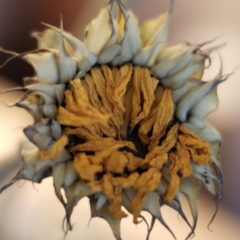
Pilot iro-utsushi: Dip pen type writing tool with a fountain pen tip
peroride posted a topic in Market Watch
Coming June 20 2022 - iro-utsushi -
Hello all and thank you in advance for your time here. I have a mother of pearl dip pen with a Spencerian number 3 nib in it which I bought a few years back at a local garage sale. It’s about 6 or 7 inches long, appears to be made of mother of pearl and sterling silver and ends in an ornate floral motif with a silver back. I can’t find any makers marks or forge marks on the silver parts of the pen. The pen came in a worn out black case, but one which seems to have been quite nice when it was new. At this point the only information I have comes from the Spencerian nib which seems to be from around the turn of the century. That and a note which came with the pen that reads “I think this pen belonged to my mother” ~Elsie. The woman I bought the pen from was in her early 70s and said that Elsie was her mother. Which seems to track with the turn of the century nib. Hopefully one of the experts on this forum will see this and know more information about this pen. It rights fairly smoothly still, I am a total amateur but I enjoy drawing and the qualities of this pen are quite nice for fairly fine line work. Anyway thanks again for any help identifying this and helping me shed a bit more light on this pen’s history.
-
I was wondering if anyone has used Ackerman pens. You can use almost any ink in them with a choice of dip pen nibs... They have overfeed/ pumps etc. It seems almost to good to be true... Any personal experience would be appreciated. Thanks!
-
.thumb.jpg.fa47f5f051e847ecf4396ad6c7a7554f.jpg)
📌 Expertise needed: Rare antique European dip pen
Erika posted a topic in Fountain & Dip Pens - First Stop
Hello everyone 😊, greetings from the Netherlands! Happy to be here in the Fountain Pen Network 😁 I need your expertise. I've acquired this striking, antique personalized dip pen made of ivory from a reputable auction house. Aside from certifying the authenticity and legality of the item, they don't have information such as: Were pens like these made for military personnel, artists, medical staff at that time, etc? Were these given as an acknowledgement of a notable contribution or because of a special event? Was personalization of pens like these typical back then? I'm a complete novice on fountain pens and after hours of research, I couldn't find any leads. I just want to know the story behind it. I did find some Frans Peeters during that time period: one was a soldier, one was an artist and another one was a Belgian architect. I don't know if the any of them is the Frans Peeters I'm looking for. Perhaps it's best I approach a Dutch govt. body on public records. Any info would be greatly appreciated 🙏🏻 -
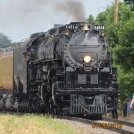
What is you favorite pen holder you have used, straight or oblique.
Finriel posted a topic in Fountain & Dip Pens - First Stop
Hey y’all wondering what are some great pen holders straight and oblique. Also wondering about good dip pen ink. thanks in advance!- 14 replies
-
- pen holder
- dip pen
-
(and 1 more)
Tagged with:
-

What is in your opinion the best flex nib, pen ever?
Finriel posted a topic in Fountain & Dip Pens - First Stop
- 24 replies
-
- flex nib
- fountain pen
-
(and 2 more)
Tagged with:
-
Hello everyone 😊, greetings from the Netherlands! Happy to be here in the Fountain Pen Network 😁 I need your expertise. I've acquired this striking, antique personalized dip pen made of ivory from a reputable auction house. Aside from certifying the authenticity and legality of the item, they don't have information such as: Were pens like these made for military personnel, artists, medical staff at that time, etc? Were these given as an acknowledgement of a notable contribution or because of a special event? Was personalization of pens like these typical back then? I'm a complete novice on fountain pens and after hours of research, I couldn't find any leads. I just want to know the story behind it. I did find some Frans Peeters during that time period: one was a soldier, one was an artist and another one was a Belgian architect. I don't know if the any of them is the Frans Peeters I'm looking for. Perhaps it's best I approach a Dutch govt. body on public records. Any info would be greatly appreciated 🙏🏻
-
Hello everyone 😊, greetings from the Netherlands! Happy to be here in the Fountain Pen Network 😁 I need your expertise. I've acquired this striking, antique personalized dip pen made of ivory from a reputable auction house. Aside from certifying the authenticity and legality of the item, they don't have information such as: We're pens like these made for military personnel, artists, medical staff at that time, etc? Were these given as an acknowledgement of a notable contribution or because of a special event? Was personalization of pens like these typical back then? I'm a complete novice on fountain pens and after hours of research, I couldn't find any leads. I just want to know the story behind it. I did find some Frans Peeters during that time period: one was a soldier, one was an artist and another one was a Belgian architect. I don't know if the any of them is the Frans Peeters I'm looking for. Perhaps it's best I approach a Dutch govt. body on public records. Any info would be greatly appreciated 🙏🏻
-
Hello everyone 😊, greetings from the Netherlands! Happy to be here in the Fountain Pen Network 😁 I need your expertise. I've acquired this striking, antique personalized dip pen made of ivory from a reputable auction house. Aside from certifying the authenticity and legality of the item, they don't have information such as: Were pens like these made for military personnel, artists, medical staff at that time, etc? Were these given as an acknowledgement of a notable contribution or because of a special event? Was personalization of pens like these typical back then? I'm a complete novice on fountain pens and after hours of research, I couldn't find any leads. I just want to know the story behind it. I did find some Frans Peeters during that time period: one was a soldier, one was an artist and another one was a Belgian architect. I don't know if the any of them is the Frans Peeters I'm looking for. Perhaps it's best I approach a Dutch govt. body on public records. Any info would be greatly appreciated 🙏🏻
-
I recently acquired some walnut ink crystals from Paper & Ink Arts. This makes a very beautiful ink (not entirely dissimilar to J. Herbin's Cacao du Brésil, but browner overall), which seems pretty smear resistant when dry, but is not at all waterproof. I've added a bit of gum arabic, which I think improves the behaviour for the dip pen, but also seems to do nothing for waterproofing. (Iron Gall inks obviously might have more waterproofing, but I don't really want to use these with a dip pen, I don't think.) Thinking about "India inks", some of which have water-resistance, I was wondering about mixing shellac into the walnut ink. I see recipes for carbon black ink with shellac, but I haven't seen any for walnut-based inks. I don't see any reason why this shouldn't work though. Does anyone have any experience doing something like this? (I see a variety of shellac flakes are available, from very light-coloured "Platina" to "Blonde" to "Orange" to "Garnet"; I don't know if for the amount of shellac that one would add to an ink the colour of the flakes would make much difference. At least one of the ink recipes I saw for carbon-black ink called for pulverising the flakes, I suppose this is better than dissolving in alcohol when thinking about use on a dip pen?)
-
Hello I’ve been using dip pens for handwriting for a very long time now, but I’ve either used whatever nibs the pens came with, if antique, or just picked from whatever nibs came with it if it was a modern calligraphy pen set. I need to get a new one, and I’m trying to think a bit more systematically about nib selection. I handwrite a lot (I hate typing) but my handwriting is rather poor and scribbly, which is one reason I’ve used dip pens for so long - because they force me to slow down a bit and take greater care. I’m certainly no calligrapher. Does anyone have any recommendations for the best nib type for general-purpose handwriting with a dip pen? I need something with a reasonable flow rate and not prone to spatter when writing quickly. Thanks - suggestions much appreciated
-
Hello! It's been a long time since I've posted here, but I thought that the deal I found last week might intrigue some folks (with pictures). Apparently the Dollar Tree (US-based store where all items are priced at $1) is now in the business of selling glass pens + coordinating ink! Quite surprisingly, it's not too scratchy and does a great job retaining ink between dips, both with the provided ink and other FP inks (I have not yet tested it with shellac-based inks.) The provided ink bottle is 6.8ml (0.23 fl oz) in a dark, mossy green which matches the pen shaft. Very slight shading.
-
Cone-shaped mystery - Usage, manufacturer, place to find?
Rawrik posted a topic in Fountain & Dip Pens - First Stop
Hello there, Took an interesting hobby to hoard weird, unusual, peculiar nibs to find new means of calligraphy. Recently, I've bought a whole little box stuffed with old nibs in antiques in Prague and I encountered this little guys. I can't really identify them, no matter how my english description is plaguing Uncle Google. This nibs?/cones?/resevoirs? whatever isn't working anymore, but apparently you drip some ink in it and the stick in the end of cone will let ink down by pressing it against papper (hence the spring). That's just so much to my reverse engineering. I tried to let it stay in warm water to clean content in it, solve the rust away in vinegar and brush it of in baking soda. None of it make it better. I'm looking forward to buy a new one, but there is nothing like brand or signature of manufacturer, which would hint its origin. So I figured out that you, guys, may help me. Tried to find it here for what felt like hours, so I submit this thread (after I sign up to this amazing community!). It may be regular model of some stationary tool I didn't know about, or some rare oddity not really used in any time. tags I used in forum, google: cone, funnel, nib cone-shaped, unusual nibs, calligraphy dip cone type, so on.. (I really tried) Value every opinion. (mobile photos, bad quality :(( )- 24 replies











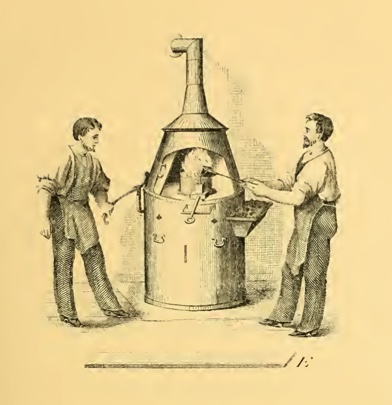
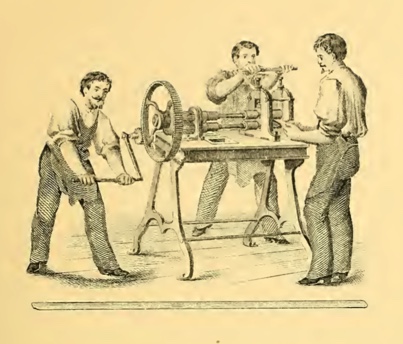
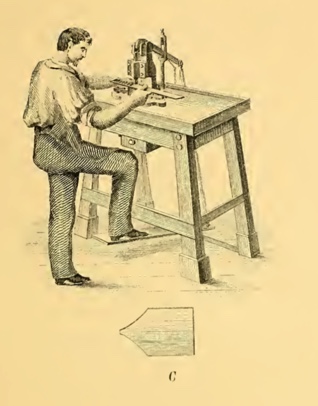
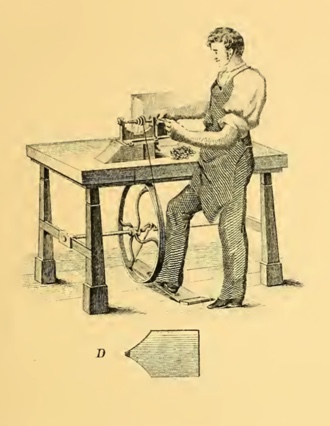

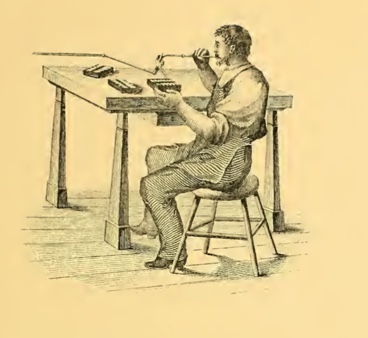

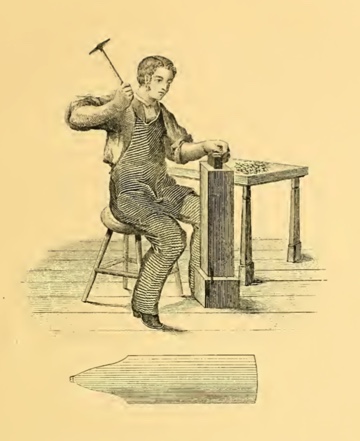

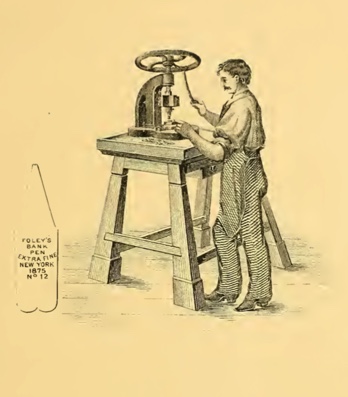


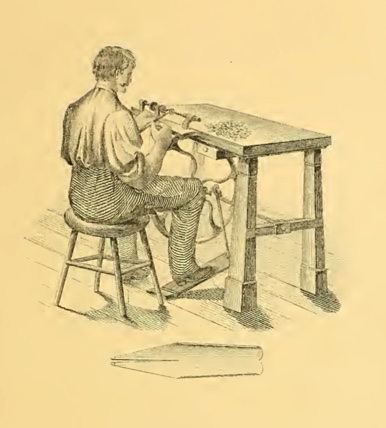

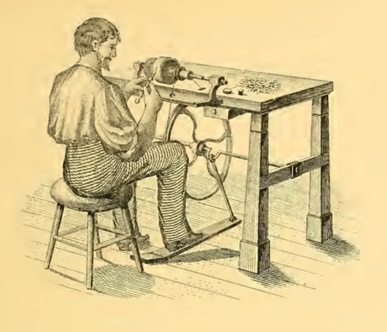
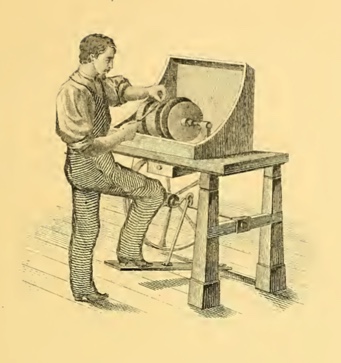
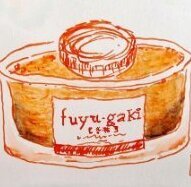
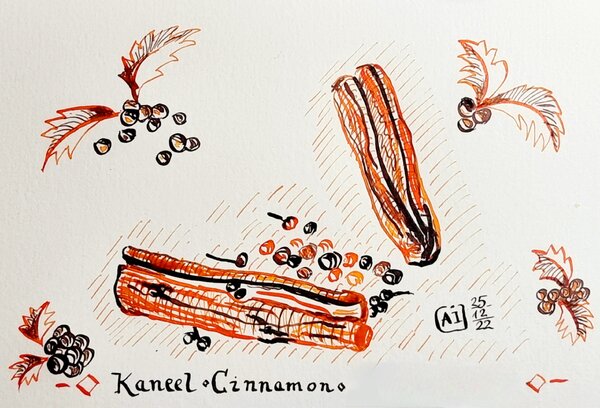
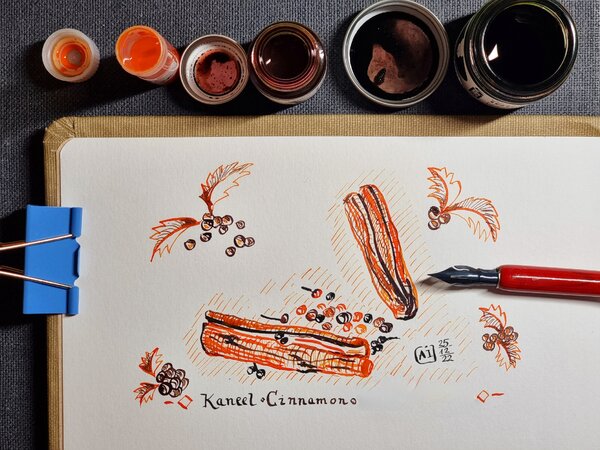

desaturated.thumb.gif.5cb70ef1e977aa313d11eea3616aba7d.gif)
